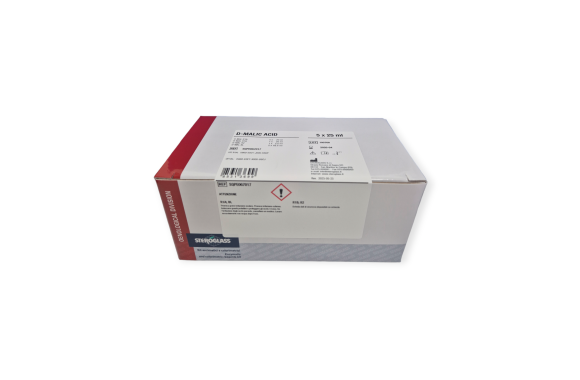D-Malic Acid Kit
Contact our expert for more informations.

The D(+) dextrorotatory isomer of malic acid plays a marginal role in oenology as the vine tends to accumulate mainly L-malic acid, the substrate of malolactic fermentation. D-malic acid may be present in traces, significant quantities may result from food adulteration; the addition of L-malic acid to correct the acidity of wines is permitted in accordance with current regulations.
D-Malic Acid is a key component that influences the balance between acidity and sweetness in wine, contributing to the final taste. Its concentration can influence both the microbiological and chemical stability of wine.
To determine the amount of D-Malic Acid, choose Steroglass enzymatic and colorimetric kits. They are easy to use because they are liquid and ready to use!
Benefits
-
MALIC ACID
Malic acid accumulates in the early stages of berry development and decreases during ripening due to dilution and respiration. Viticultural practices and the grape cluster environment can directly influence the respiration rates of malic acid. Malic acid levels affect the pH and titratable acidity of the wine. During malolactic fermentation, malic acid is converted into lactic acid, resulting in the loss of an acidic group. The impact of this reduction on pH depends on the initial amount of malic acid and the buffering capacity of the wine. In wines with low levels of malic acid and high buffering capacity, malolactic fermentation will have minimal effect on pH. Conversely, in wines with high levels of malic acid and low buffering capacity, fermentation can cause a substantial increase in pH. Malic acid tends to be higher in cooler vintages.
Technical features
ADVANTAGES
READY TO USE: Liquid and easy to use.
PRECISION AND SPECIFICITY: Characterized by high specificity, they provide accurate and repeatable data.
LOW COSTS AND LONG SHELF LIFE: Minimal cost per test and a long shelf life (average 24 months).
FAST ANALYSIS: Allow for quick and reliable results (up to 300 tests/hour), especially when used with automated instruments like our HYPERLAB series analyzers.
SIMPLE AND ECONOMIC CALIBRATION: It is possible to use single-method and/or multi-parametric calibration/verification standards. The determination of the Blank is performed automatically every 12 hours with the Hyperlab analyzers.
METHODS APPROVED BY INTERNATIONAL STANDARDS: Numerous enzymatic methods have been approved and validated by international organizations such as:
ISO (International Standardization Organization)
AOAC (American Association of Analytical Chemists)
IFU (International Federation of Fruit Juice Producers)
OIV (International Wine Office)
IDF (International Dairy Federation)
EBC (European Brewery Convention) and many others.
KIT ENZIMATICI E COLORIMETRICI STEROGLASS
I kit enzimatici e colorimetrici sono ampiamente usati nel controllo qualità per le principali determinazioni analitiche dei più svariati prodotti alimentari quali: succhi di frutta, vino, birra, latticini, uova, carne e per il controllo dei processi di fermentativi svolti dai microrganismi per la determinazione degli zuccheri, degli acidi organici e di altri componenti quali solfiti, composti fenolici, metalli.
Basata su enzimi purificati di alta qualità, l'analisi enzimatica consente misurazioni precise, molto accurate e ripetibili, anche in matrici complesse. Infatti la variazione dell’assorbanza, misurata a livello spettrofotometrico a seguito delle trasformazioni enzimatiche, è strettamente correlata alla concentrazione dei vari analiti ricercati.
Industries
Applications
Product codes
| Steroglass code | Description | N°Analyses |
|---|---|---|
| SQPE067017 | D-MALIC ACID KIT 5x20ml |
manual 50/100 – automatic 200/300 |
